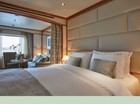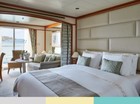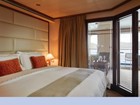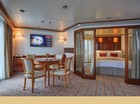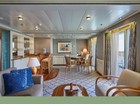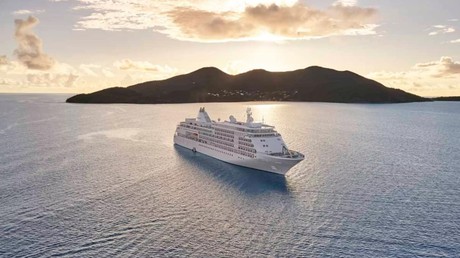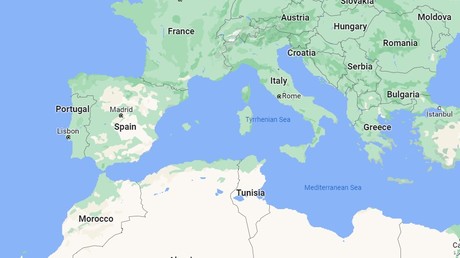Blissful beaches, beautiful sunsets and legendary hospitality welcome you on this cruise. Starting in Venice, you first stops are in Croatia, a country known for its limpid waters and kaleidoscopic history. Enjoy a days in Kotor, Monopoli, Valetta and La Goulette before embracing some style and sass in with nine days in Italy, punctuated by a day in Corsica. Sail next along the scenic south coast of France, ticking off some top spots on your wanderlust wish list. Your last country is Spain, where you’ll be as charmed by its islands as its mainland. Disembark in Lisbon.
Highlights
• Venice, Italy
• Sibenik, Croatia
• Kotor, Montenegro
• Monopoli, Italy
• Valletta, Malta
• Tunis, Tunisia
• Sorrento, Italy
• Rome, Italy
• Porto Santo Stefano, Italy
• Olbia, Sardinia
Losing none of its allure over the years, this floating city of canals, bridges and masks is a place of eternal beauty and enduring elegance. The lagoon of more than 100 islands is a heavenly sight, transporting visitors on a journey through time - from its Roman inception, through centuries of trade to the modern face we see today. Navigate Venice’s sparkling waterways by romantic gondola, or on cruises along wide canal boulevards. Span the Grand Canal over its iconic original crossing, the Rialto Bridge, which - with its parade of tiny shops - gives some of the city’s most endearing views. If the crowds unsettle you at any point, take two turns away from the main thoroughfares to find peace alone, amid the city's labyrinth of tiny streets. Hurry to Piazza San Marco to be immersed in Venice’s elegant glory. Basilica San Marco transports you back to the wealthy days of the Doges, who ruled for over 1,000 years. Initially their private chapel, it’s now decorated with beautiful Byzantine mosaics. Nearby the Campanile di San Marco bell tower offers views over the higgledy-piggledy rooftops of times gone by. Just a hop skip and a jump around the corner is the Doge’s Palace, where the levels of opulence ramp up even further. Justice was meted out in this stunning Palace, with the guilty walking to the cells across the covered Bridge of Sighs. Vaporetto trips to local islands offer even more adventures to float your boat, whether it’s Murano with its world-famous glass, Torcello with its amazing Cathedrals, or Burano with its handmade lace and delightfully colourful painted houses.
Feel the strong Italian influence as soon as you step into this city, known as Croatia’s 'Little Venice'. A gorgeous artwork of a port, you can revel in seafront promenade strolls, waterside drinks, and the tangled beauty of an immensely atmospheric old town. Nearby, islands sparkle and beaches call out, while working fishing boats add authentic everyday charm. With both Croatian and Italian languages spoken, there's more than a hint of Venice in the crisscrossing streets and soaring bell towers of this breathlessly romantic place. An alluring highlight of the Istrian Peninsula, walk the cobbled streets of Rovinj's old town, between sun-parched houses that rear up directly against the sea's lapping water. Tiny streets and squares are lined with little souvenir shops, bars, gelato stalls and restaurants serving up delicious dishes laced with Istria's elusive white truffles. Take the climb up above via the elegant Church of St Eufemia's Venetian bell tower. The tower's ascent is perhaps best viewed from the glinting waters, however, as you look back to see the church rising above the town's pretty clutch of colourful buildings. Explore the olive groves and vineyards of the sunny peninsular, on your way to villages where truffles are sniffed out by specially trained dogs, or head out to rocky coves to swim in refreshing, transparent seas. Pula is also close by - a city scattered with Roman ruins, including the magnificently preserved, in-tact amphitheatre - which continues to be a centre of entertainment, hosting atmospheric festivals and concerts to this day.
Set on the dazzling Adriatic, where the Krka River opens out into the blue, island-peppered waters, Šibenik is a stone-clad city that oozes Dalmatian medieval charm. Gorgeous Krka National Park gushes with famously picturesque waterfalls close by, while the World Heritage Sites of Croatia’s oldest native town have endless stories to tell. Rising from the shadow of popular neighbours Split and Zadar, Šibenik is successfully establishing itself as an unmissable Dalmatian city thanks to its timeless grace and 30 hidden churches and monasteries - which ring their bells above a wash of terracotta roofs. Dominating the tight streets of the charming old town - where ice cream vendors spoon out fruity flavours, and footsteps rattle along stone streets - is the magnificent Cathedral St. James UNESCO World Heritage site. Taking more than a century to construct, it is built from stone in a Gothic-Renaissance style and adorned with 71 sculptured heads - each displaying its own personality. Look closely, to notice the bullet holes embedded in the door – reminders of the fierce fighting that raged here, during the Croatian War of Independence. St. Michael’s Fortress stands on a hill above the city, providing the perfect viewpoint to see Šibenik rolling towards the stunning archipelago, which punctuates the turquoise Adriatic. Part of the fortress is now used as an open-air stage, forming an ethereal venue for performances. St. Nicholas Fortress is another UNESCO protected site and was built where the monastery of St. Nicholas once stood. Further afield, the beautiful old town of Trogir is close by, along with the Roman ruins of Salona.
Croatia's fractured Adriatic coast is scattered with hundreds of islands - but few can match the elegant beauty of lovely Korčula. Tucked away behind bustling Hvar, Croatia’s sixth-largest island is a little harder to reach, making for a more peaceful affair. Decorated with beautiful medieval fortifications, time stands still as you stroll narrow paths, cutting between the stone facades of Gothic and Renaissance architecture. Hear the stomps of feet and clacks of swords rattling off of the walls, during traditional Moreška performances - an enchanting, authentic sword dance. Revelin Tower looms over the grand entrance to the walled old town - nicknamed Little Dubrovnik - which was built and fortified in 1485 to protect Korčula. The island is also said to be the birthplace of Marco Polo, and his former house contains a narrow staircase leading to Marco Polo Tower, which peeks above the tight streets. The majestic Cathedral of St. Mark also rises high, and you'll spot the gorgeous vaulted bell tower, framed between narrow alleyways. Climb to the top for views of the red roof cluster, and sparkling Adriatic below. A beautiful island to explore, its dark blanket of pine tree forest led to the Greek's naming the island, Korkyra Melaina - or Black Corfu. Explore the gorgeous ring of coastline, which is lined with pebble beaches, sandy bays and hidden coves. Or, indulge in the island's tastes - like luxurious olive oils and white wines grown from grapes including posip, and grk - cultivated only on this island.
Embedded into the slopes of the steep Lovćen mountain, and overlooking the deep blue Adriatic, the fortified town of Kotor boasts a spectacular, imposing staging that few can match. Squeezing in through the tight Bay of Kotor is a daunting and impressive approach in itself, as you arrive via one of Europe’s most stunning waterways. A pearl of Montenegro and the Adriatic, Kotor's warren-like streets drip with history and authenticity. Under Venetian influence for four centuries, the city's UNESCO World Heritage Site old town invites you to wander amid atmospheric stone-clad streets, overlooked by a sea of terracotta roofs and the double towers of the cathedral. Protected by thick stone walls - and the mountains behind - Kotor draws comparisons with another fortified Adriatic wonder in Dubrovnik. Many favour Kotor for its compact layout, smaller crowds, and authenticity, however - having been spared from shelling during Yugoslavia's breakup. The tightknit streets here are patrolled by a slinking population of feline residents, who were adopted as the town’s mascots, after being left behind by transient trader ships. Learn of the city's extensive heritage on the waves, in the dedicated maritime museum that is contained within Grgurina Palace. Pick your way through tight alleys of workshops and studios, walking below fresh laundry strung from windows, before settling into shiny, paved piazzas for an afternoon coffee or seafood meal. If you’re up for an aerobic challenge, tackle the 1,350 steps up the steep walls to St John's fortress. The views over the gorgeous bay make the arduous slog worth it, as you rise past the city's eye-catching 15th-century church bell tower.
Located in the heel of Italy’s boot, Monopoli is a Puglia port town that knows how to make a splash. In fact, the words Monos and Polis mean singularly unique – and Monopoli’s special blend of part historical, part functional is most definitely that. The city might lack some of the more aesthetic elements of its neighbours, but that only means good things for those who do discover it: far from the tourist route you’ll be greeted with medieval churches and castles, white stone buildings (contrasting perfectly with the azure of the sea and sky) and authenticity in buckets. Founded by the Greeks in 500 BC, then taken over by the Romans (and beset by various invaders), Monopoli was – and still is – a thriving port town. It’s position in Puglia between the seas made it strategic, while its placement on the Via Traiana (which led all the way to Rome) made it prosperous. The city came under Venetian control in 1484 and much of Monopoli’s architecture can be attributed to this period. The charming Old Town is dominated by Castello Carlo V, built in 1552, while the still solid Baroque-Romanesque cathedral, built in 1693, is considered as positively modern. Like most of Italy, the food here is as important as religion. As a port town, fish and seafood are deliciously fresh. Do not miss tasting “scapece” (small fish covered in flour, deep-fried, put in layers with breadcrumbs and saffron, then soaked with vinegar) for a tasty treat that you will find nowhere else in the country.
Days at sea are the perfect opportunity to relax, unwind and catch up with what you’ve been meaning to do. So whether that is going to the gym, visiting the spa, whale watching, catching up on your reading or simply topping up your tan, these blue sea days are the perfect balance to busy days spent exploring shore side.
Perched high on the imposing Sciberras Peninsula, Valletta immediately presents its massive, protective walls and vertical bastions to visitors arriving by sea. Rising to 47 metres in places, the fortifications protect lavish palaces, grand domes and illustrious gardens. Built by the Knights of St John on the narrow peninsular, Valletta is a compact, richly historical treasure trove of Baroque wonders. Ascend to reach the restful, flower-filled Upper Barrakka Gardens, where cannons fire and boom in salute at noon each day, sending echoing cracks of noise out across the waves below. Recognised as 2018’s European Capital of Culture, Valletta is a fascinating and dense haven of history and intrigue. A busy, bustling capital, the breathtaking St John’s Cathedral - commissioned in 1572 - is almost concealed among its narrow streets. The relatively modest exterior is counterpointed by a staggeringly opulent, gold-leaf bathed interior, containing a Caravaggio masterpiece - the shadowy vision of the Beheading of St John. Cinematic and magnificent, Valletta has served as a filming location for Game of Thrones - but real epic history abounds on this rocky isle too. From the prehistoric and megalithic sites of the Hypogeum of Paola and Tarxien, to the fascinating War Museum at Fort St Elmo. Mdina also waits nearby, and the former medieval capital is a striking contrast to the island’s main city. Cars are barred from its streets, and it offers endlessly atmospheric old-time wanders. With a strategic positioning in the Mediterranean, Malta is a jewel that many have wrestled for over the centuries. Independence from Britain was finally achieved in 1964, but the close allegiance remains evident, with English recognised as an official language, cars driving on the left, and red post boxes and telephone gleaming in Malta’s sunshine.
Tunisia's capital lies at the western end of the shallow Lake Tunis, which opens to the sea at La Goulette. This is the first of a string of beach suburbs that stretches away to the north; it is here that the city's port is located. This coastal area includes the ruins of ancient Carthage and the picturesque suburb of Sidi Bou Said, places that attract more visitors than Tunis itself. As far as capital cities go, Tunis has an easy-going, unhurried air about it. It is a very liberal city by Islamic standards and certainly leading the way in Western trends for the rest of the country. In Tunisia, the struggle for independence didn't take the violent course that it did in Algeria. Ruler Ahmed Bey, who governed from 1837 to 1855, encouraged Westernization and brought in military and other advisors to this end. In 1861, during the reign of Mohammed Sadiq, a constitution - the first in the Arab world - was proclaimed. Until the time of the French protectorate, the medina was very much the center of things. Then, under the French influence, the ville nouvelle (new city) emerged with its major banks, department stores, and administrative services. The main focus of ville nouvelle is the wide, tree-lined Avenue Habib Bourguiba. At its western end, this major thoroughfare becomes the Avenue de France, terminating in the Place de la Victoire and the entrance to the medina.
Surrounded by glowing turquoise waters and rugged coastline, Trapani invites you to explore western Sicily's ruins, intense flavours, and sun-soaked leisure pursuits. Built on salt and tuna exports, Trapani is experiencing a renaissance, having been lovingly spruced up as a sailing capital, and an international airport bringing in visitors from far and wide. The town looks out over the Egadi Islands, gazing west to witness some of Siciliy's most evocative sunset displays. Start exploring Trapani from its historic core, a dense network of alleys hosting a collection of small shops, restaurants and wine bars. You’ll encounter the Cathedral of San Lorenzo – where colourful artworks are spread below sweeping arches and a beautiful domed roof. Sicily feels like an island on the cusp of continents, and Trapani practically has one foot in Africa, as you soak in its pretty whitewash houses and fusion of foods and arts. Discover the Ancient Greek influence by venturing to rich archaeological sites nearby, like Selinus and Segesta, where the treasures from the past have been unearthed and displayed. Pyramids of white salt rise up at the Riserva Naturale Saline di Trapani e Paceco. These salt marshes and windmills are a symbol of Trapani, and although sea salt production is much less important today, the small white hills remain a Trapani landmark. Look out for the pink flamingos wading in the salt pans below. For beach days, the Egadi Islands can be easily reached from Trapani - Favignana is the largest and most popular.
Sorrento's colourful, sun-faded facades cascade down from green hills and cliffs to the Bay of Naples' gently lapping waters. The perfect base for exploring this Italian corner of outstanding natural beauty, venture to the curvaceous roads of the Amalfi coast - or enjoy leisurely jaunts across the shimmering waves to Capri's gem of an island. While it makes for a fantastic jumping-off point, Sorrento itself has oodles of rustic fishing town charm, so don't rush off too quickly. Piazza Tasso is the locals’ main meeting spot and a starting point for a wander through the picturesque streets. Throw back a quick espresso caffeine kick at a standing cafe, before strolling through Corso Italia - Sorrento's spine - which is lined with boutiques, museums, bars and restaurants. The historic Church of San Francesco blossoms with colourful celebrations of weddings, which spill out into its gorgeous ivy-tangled cloisters. Or head down to relax by the small beach and fishing-boat filled harbours. The looming, cloud-wisped cone of Mount Vesuvius is unlikely to escape your attention, and this now docile volcano was responsible for a famous tale of destruction when it wiped out the ancient city of Pompeii in a heartbeat. Known for the haunting, frozen casts of the city’s unfortunate inhabitants - the massive site is a miraculous snapshot of an Ancient Roman city in its pomp. Wander the stone slabs streets, visit the beautiful theatre, and the columns of the sprawling ancient forum – painstakingly recovered and rendered from below the ash. If you’re feeling a little peckish, enjoy quick and delicious flame-cooked pizzas of oil, basil, tomato, and buffalo mozzarella. The volcanic soil imbues the local wines with rich flavour – soak in the waterfront views while savouring Taurasi and Lacryma Christi flavours. Or sample the luminous lemony-hit of ubiquitous limoncellos.
All roads lead to Rome, and with good reason - this city is one of the world’s most thrilling, offering unmatched history along every street. An evocative, inspiring and utterly artistic capital of unrivalled cultural impact, Rome is a city of back-to-back landmarks, which will take you on an exhilarating journey through the ages. This may be one of the world’s oldest cities, but it’s well and truly lived in. The ruins are punctuated with murmuring cafes, and the outdoor seating of restaurants sprawls out across piazzas, enticing you to sample tangles of creamy pasta and crispy pizzas. Rome’s incredible Roman Forum is littered with the ruins of its ancient administrations, which have stood firm for 2,000 years, since the times when the area was the centre of the Western world. Few sites are more simultaneously beautiful and haunting than that of the storied Colosseum, which looms deep into Rome’s rich blue sky. Take a tour to learn details of the grisly goings-on within. The best way to experience Rome is to wander its streets, gelato in hand. There is a lot to see here - whether it’s the domed spectacle of the Pantheon, or the elaborate flowing waters and artistry of the Trevi Fountain. Vatican City is an astonishing, colossal display of Catholic grandeur, while the Spanish Steps – crowned by the Trinità dei Monti church – offer a beautiful spot to gather and soak up the lively atmosphere of this humming city. With so much on the to-do list, you’ll relish the breaks you take, enjoying simple pleasures like a strong espresso, or fresh pasta with tomato sauce and ripped basil.
A summer escape for Rome’s historic elite, the stacked waterfront of Porto Santo Stefano is a secluded taste of idyllic southern Tuscany. Physically closer to Rome than Florence, the city is strung to Italy’s western coast by two sandy harnesses, and sits on the unqiue peninsula of Monte Argentario - which was once an island. Flamboyant pink flamingos and herons stroll through the encased lagoon, while Porto Santo Stefano’s waterfront hums with clinking cafes and strolling visitors. The luxury yachts in the harbour show that Porto Santo Stefano has lost none of its luxury appeals, and with beaches, wild hikes and waterfront beauty, it continues to lure visitors to this secluded escape. Known for its fishing and cuisine - which is based around heavy use of the Tyrrhenian Sea’s juicy bounty. Stroll to Piazza dei Rioni for a dripping lemon gelato, or wander the streets noticing the lingering World War II damage – the city was heavily bombed during the conflict. Fortunately, the historic, star-shaped, Spanish fort was spared, and it still watches out resolutely over the waters. Built during the Napoleonic Wars, it fortified the exposed town against pirate raids, and offers beautiful views over the old town's terracotta roofs. Rugged coastline falls to secluded beaches, with a wilder, unkempt charm. Sail the coves - seeing cascading olive groves - or island-hop to Giglio and Giannuti, which lie 12 miles from shore, and can be seen from the monastery topped Argentario mountain. On the other side of the promontory, you’ll find Porto Ercole - where the lifeless body of the Old Master, Caravaggio, was discovered.
Napoleon Bonaparte may have been forced into exile here in 1814, but nowadays this picturesque Tuscan island draws no end of visitors who come by their own free will. Offshore in the Tyrrhenian Sea, Elba is a mountainous mirage of glowing beaches, turquoise waters, and craggy coastline. The island capital’s sun-faded pink and yellow buildings stack up over the waterfront, offering sweeping views back to the mainland. The harbour's tiny wooden fishing boats are now dwarfed by the gleaming yachts that visit, and Elba invites you to join them, dropping in to relish a secluded, sun-soaked taste of the island's good life. Elba is the third biggest Italian island, and the protected Tuscan archipelago’s largest, with no fewer than 90 miles of gorgeous coastline rolling out for you to explore. Grown from the ruins of the Roman settlement of Fabricia, steep fortifications and a scenic natural harbour all add to Portoferraio's appeals. Bonaparte hung around for just ten months - but the sea panorama from his former residence, Villa dei Mulini - which is now a museum - keeps visitors coming back for more. An island of steep inclines, which reward with spectacular vistas, Elba’s villages cling to precipitous drops, while beautiful beaches unravel along its shores and enchanting scenery of chestnut tree woods, olive groves and vineyards coat its lands. Take the cable car up to Monte Capanne - which offers more of the island's trademark views, without the need to break a sweat. Settle down to taste the island’s succulent seafood, and tuck into juicy, grilled sardines and plump octopus - rounded off with a glass of the famous local, sweet wine.
An energetic little town, where authentic Sardinian life plays out, Olbia welcomes you to the island’s heart-meltingly attractive northeastern coastline. Explore a land where glorious turquoise oceans and white sands meet, and cork and olive trees grow wild. Swish golf clubs on courses hugging the electric-blue waters, ride the terrain on mountain bike trails, or recline on powder-soft sands - the choice is yours in Olbia’s exclusive, sun-soaked outdoor playground. Corso Umberto is the paved, flower-decorated spine of Olbia - a buzzing pedestrianised street that runs from the waterfront and hums with restaurants and shops. The town’s atmospheric narrow streets eventually lead to the small squares of Piazza Regina Margherita and Piazza Matteotti - perfect for a shaded drink and a sit down in their clusters of animated cafes. Wander to find Basilica di San Simplicio, a simple granite structure that dates back to the 11th century, and is decorated with glowing 12th-century frescoes. The zigzagging rainbow coloured tiles of the Chiesa di San Paolo’s dome beam in the sunshine, and add a splash of colour to the town’s humble skyline. The coastline around Olbia is some of Sardinia’s finest. Head to the Costa Smeralda, where some of the most beautiful beaches in the world sparkle. An area of immense beauty, white sand crescents like Capriccioli stand protected by junipers, pine trees and olive trees growing wild. Wander the secluded sands where turtles lay their eggs or relax in the opulence of luxury resorts. There are beautiful beaches closer to Olbia too - Porto Istana sandy beach offers crystal clear, shallow water that is ideal for swimming and sun worshipping.
Calvi’s illustrious citadel dominates the city’s harbour, watching over a port bustling with luxury yachts dropping anchor, and well-heeled visitors wandering the Quai Landry’s elegant seafront promenade. Cafes and restaurants clink and clatter, while the interplaying voices of trios of Corsica’s polychronic singers provide a wonderfully evocative soundtrack. Calvi’s grand, moon-shaped bay, completes the postcard-perfect appeal, and you can wander the fringe of soft sandy beach which stretches for five miles. Or, dip into the tempting turquoise waves that lap softly against the shore, while admiring the crowning glory of Calvi’s majestic citadel. The stacked 13th-century Genoese fortress is Calvi’s heart and has played a central role in fending off invaders from across the waves throughout the city’s history. Positioned high above the port, and overlooking the sea below, there’s a labyrinth of cobbled streets tucked in behind its steep, protective walls. The clanging bells of the domed Cathedral St. Jean Baptiste echo evocatively down its stone-clad streets, and the church has a rustic beauty to its faded, sandpapered façade. Reach the ruins of a humble house – destroyed by Lord Nelson’s besiegement of Calvi - and you may raise an eyebrow at the signs proclaiming your arrival at Christopher Columbus’s birthplace. Raise your suspicions with the locals, however, to be met with pityingly smiles at your naïvety – they firmly believe the common theory that he was born in Genoa was a deliberate piece of misinformation spread by Columbus himself. Twist up through the fragrant pine trees of Chapelle de Notre Dame de la Serra for a spectacular view of Calvi’s majesty unfolding before you. Best appreciated at sunset, you can absorb the view with the last rays of the day bouncing off the tips of the waves below, as you’re embraced by the island’s ragged mountains and Calvi’s timeless beauty.
Effervescent and exclusive, Portofino rests on a privileged peninsular. Lavish yachts mingle together, seeking out sought-after berths in the harbour, while gelato drips onto the stone-paved streets in this, the most alluring and glamorous town of the Italian Riviera. This section of the Ligurian Coast is a protected area, and home to some of the country’s most picturesque, and jaw-dropping scenery - which is best viewed from the deck of a sailing boat. Crisp white villas roll out across the verdant green hillsides, surrounded by laden vineyards and olive groves. Down in Portofino itself, the buzz of chatter and the clatter of cutlery, provide the soundtrack to busy terrace bars and restaurants, which serve up fine food and delicious sea views. Portofino’s achingly beautiful harbour arcs around the lapping waves, with a warmly-hued waterfront of peach and apricot colours - which also adorns postcards and promotional travel guides of Italy. For the authentic Portofino experience, sail out onto the tranquil waters of the Gulf of Tigullio, to mingle amongst the privileged at play, or settle back in the shade as you take aperitivo on the picturesque waterfront Piazzetta. Here you can sip the famous Ligurian wines, and stave off hunger with focaccia con il formaggio - or platters of fine cheese and hams. Deeper into Portofino, you’ll find artisans crafting their wares and weaving together lace, or you can ascend to viewpoints like the lemon shaded Church of San Giorgio, to look over the pretty jumble from up above. A wander out along the headland to the tapering tip of the peninsular, rewards with the views of Portofino’s iconic white lighthouse beaming out light and welcoming ships to this slice of Riviera heaven.
There are few more elegant places to salute the sunset than Terrazza Mascagni, Livorno’s refined chessboard piazza. A historic port, and a beachy gateway to Tuscany, Livorno welcomes you ashore to explore this enchanted Italian region's sun-soaked beauty, rich flavours and world-renowned fine art. Stay in Livorno to explore 'Piccolo Venezia', or ‘Little Venice’ - a quarter of the town that's laced with canals, little marble bridges and plenty of tempting eateries. With its bustling market, fortresses and iconic waterfront, there’s plenty to keep you busy here, but most will be tempted to venture inland to explore more of Tuscany’s many charms and artistic wonders. Test your nose, as you breathe in the subtleties of Tuscany’s vineyard-draped scenery, and visit wineries showcasing the best of the renowned flavours of the Bolgheri wine-growing area. Or head out to Prato, where you’ll find tightly-woven textile history. Pisa’s showpiece tower is within reach, as is Florence’s city of immense and imaginative renaissance beauty. Admire the delicate carving of Michelangelo's masterpiece, the David statue, and note the provocative stance as he casts a dismissive glance towards Rome. Stand before the city’s majestic black and white cathedral - the Cathedral of Santa Maria del Fiore - with its colossal brick dome. The view down over Florence's river and grand dome from Piazzale Michelangelo, meanwhile, is one of Italy's finest. However you choose to spend your time in Tuscany, you’ll discover an artistic region, filled with beauty designed to appeal to every sense.
Scattered along the dramatic emerald Ligurian coastline, the five towns of the Cinque Terre sprawl down cliffs, and splash bursts of colour into mountains that drop off abruptly to gently bobbing waves below. Set above the rich blue water, this precious gathering of fishing villages is a wonder of the Italian coastline. Connected by rail, hiking trail and sea, cars have been largely eschewed and traditions kept alive on this romantic coastal stretch, where each of the interlinked towns preserves its own distinct personality. Portovenere - itself a gorgeous, colourful fishing village - is the gateway to the five towns, which cling to the cliffs of this terraced landscape. Monterosso is the largest, and you can sunbathe on its sandy beach, or explore the town's gorgeous Medieval core. Vernazza is one of the smallest, but perhaps the most pretty and elegant. You'll be rewarded with an authentic fishing village ambience once you arrive, following an achingly beautiful sea approach. Manarola is another of the smaller options, perching higher up on the rocks and surrounded by fertile vineyards and olive groves. Joined by hiking paths, and pretty little ports, you can explore the chain of gravity-defying towns as you wish, ticking them off at breakneck speed, or settling into a café to soak in the sea view, and sleepy way of life. Or head across the waters from Portovenere's gorgeous, stacked waterfront to Palmaria Island's unspoiled hiking terrain - also part of the Cinque Terre and Portovenere's UNESCO World Heritage Site listing.
Happily preserved from much redevelopment, mountains frame belle epoque villas, painted in sun-faded pastel shades, an azur sea shimmers. It’s picturesque and lush with exotic botanical delights.
Just a quick skip from Monaco and the last stop on the Cote de d’Azur before Italy, Menton isn’t the celebrity haunt like some of the flashier resorts of the coast, but it’s not exactly undiscovered either. It was already a fashionable winter retreat for the travelling nobility in the 19th centaury, even gaining a royal seal of approval from Queen Victoria.
Inspired by the subtropical microclimate, well heeled 19th centaury aristocrats planted lavish gardens now open to the public, bursting with rare, tropical plants from their travels and the largest collection of citrus trees in Europe, with over a hundred different varieties.
Menton has a legendary love affair with lemons culminated in the creation of a lemon festival in the 1930’s that’s still held today at Mardi Gras. It’s quite a sight to see, themed floats and sculptures made of lemons and oranges.
The charms of Menton did not escaped prominent artists and writers. Picasso, Duffy, Monet, Zola and Flaubert amongst many others have all found inspiration here. Perhaps none so much as Jean Cocteau - artist and director. The admiration was mutual, there’s a fantastic museum dedicated to his work as well as visits possible to buildings he was given free rein to decorate.
There’s a lot to look at as you sip your citron pressé!
Nice's sweeping bend of brilliant-blue seawater - which once tempted the aristocracies of Europe - continues to entice and entrance visitors to these sun-soaked shores. A refined city of airy ocean boulevards, grandiose buildings and open spaces, fountain-sprinkled parks and colourful floral displays add to the city's timeless appeal. Nice has lost none of its old-world lustre, and there remains something of the divine in the Bay of Angels' endless sparkling waterfront. The vast, open Promenade des Anglais remains Nice's magnificent crowning glory, inviting the city out to jog, wander and glide along the Mediterranean's most spectacular curve of seafront promenade. Dotted with sun worshippers and swimmers, it's an ode to the rejuvenating character of that unbeatable duo - the rich blue sea and endless sunshine. The crisp, clear, golden light also continues to make Nice a destination of creative pilgrimage, and Matisse, Picasso and Renoir are among the many artists to lavish in the city's eternal beauty. Drag yourself away from the waterfront to discover the old town, punctuated with Baroque churches rising, and the wafting scents of baking pastries, and lavender bundles. Follow the floral odours to Nice's famous flower market, which spills gorgeous colourful displays along Cours Saleya. There's a strong hint of Italy, explained by the fact that Nice only aligned with France in 1860 - following 500 years under the House of Savoy. A gorgeous Orthodox Russian church also rises incongruously with colourful onion domes, forming one of the city's unusual sights, and one of the largest such cathedrals outside of Russia. Walk in Nietzsche's footsteps and climb up to Colline du Château's charming green park and cascading waterfalls, to relish the views down over the city and sparkling sea expanse. Not without challenges over recent years, Nice continues to bloom and inspire its visitors with an intoxicating allure of sun, sea and sophistication.
A glitzy, glamorous coastal resort that needs no introduction, Saint Tropez is the French Riviera hotspot of choice for A-listers and flotillas of gleaming yachts. The sparkle of its beaches, and clarity of its light, continues to attract artists - but it was the famous presence of Brigitte Bardot that leant Saint Tropez its enduring glamour and steamy appeal. Nowadays, speedboats skim offshore, while fine vintages from the vineyards nearby are uncorked in top-notch restaurants, in this well-heeled highlight of the Cote d'Azur. Famous bars offer views of the port along Quai Jean Jaurès, with its iconic cherry-red directors' chairs. Here you can admire the monstrous wealth of yachts that sparkle on the waters. On the same corner, big-name brand labels glimmer in the shops of rue François Sibilli - which cuts inland from the charming waterfront. The earthier appeal of boules clinking and thumping into the ground can be enjoyed at Place des Lices, where sun-wrinkled locals compete. Saint Tropez has a few beaches of its own, but famous stretches like Pampelonne Beach draw the biggest crowds to relax on star-studded golden sands. La Ponche, the authentic fishing quarter, retains its cobbled, historic elegance, and a 17th-century, hexagon-shaped citadel watches over the city and coastline from above. Coastal walks in the sea air snake away from the city’s bustle, and a series of headlands shape the stunning riviera landscape surrounding Saint Tropez. The historic monochrome Cap Camarat lighthouse adds a pleasing accent to hikes above the sparkling Mediterranean’s waves.
The south coast of France is nothing if not beautiful. To the east you have the sparkling seas of the Riviera while to the west, the terrain becomes craggier, less built upon but no less lovely. As you travel west ports get smaller and less glossy – but remain undeniably authentic. Such is true of Collioure. This charming seaside resort might not have the mega yachts (or mega bucks) of St. Tropez and Monte-Carlo, but it certainly has a local flavour that is unique to the south-west of France. So much so that the post-impressionist movement Fauvism was immortalised here. Apparently the movement was created when artists including Matisse, Picasso and Derain arrived in 1905 and realised they could not purchase black pain in the area. They were thus forced to find a creative solution to their problem. The answer was, of course, the dotty pictures that defined 20th century art. So magnetic was the region that others flocked to the area, and even today Collioure’s church is one of the most painted locations in France, with a record 242 reproductions. So perhaps the best guide to Collioure is not the usual guide books, but rather a crash course in modern art. Little seems to have changed since the painters left the seaside village, olive and lemon groves are still abundant, grape vines still line the horizon and stone cottages still stand. Cicadas still sing, fishing boats – bringing home the region’s speciality of anchovies – still float, and life carries on very much as it must have done in 1905.
Happy to sit out of the limelight that Ibiza and Majorca bathe in, Menorca lives life at its own pace, offering endless pine-tree fringed beaches and an appealing, mellow approach. The capital of Menorca is a bashful member of Balearic Islands, which wait off of the sunny Spanish coast. With atmospheric old towns, tiny fishing villages, and unspoiled beach coves, this is one of the group’s lesser-known and explored gems – and all the richer for it. A UNESCO Biosphere Reserve, there are wetlands and rolling sand dunes with diverse wildlife to explore - and 220 different birds soar and wade within. The designation helped to halt the threat of overdevelopment, and with gloriously clear waters and leisurely boating trips to enjoy, Porto Mahon welcomes you to a wonderfully preserved and characterful island. The island’s capital spills around the Med’s largest natural harbour, which sprawls out for three miles. Wander the whitewash town’s streets, heading for the hubbub of the fish market – to sample the best of the day’s freshly prepared haul. The majestic organ that fills the interior of Santa Maria church with over 3,000 pipes is a sight to see and can produce a wonderful, gut-vibrating noise. Filled with pottery and cake shops, there’s an artsy, laid back and creative atmosphere to Porto Mahon’s streets. Swing a golf club, and crack drives through the salty sea air of Porto Mahon, or rumble along the paved bike paths that ring the island exploring between wildflower sprinkled fields and stone walls. Or, head straight for the many beaches and turquoise seas, which are blotched with dark blue patches. When it’s time for a sit down in the shade, order up a refreshing pomada - gin and lemonade – before settling on your sandy nook of choice, to watch the setting sun sinking into the warm of the waves of the Mediterranean.
A rugged Mediterranean gem, arising out of the rich blue haze, Mallorca is a Spanish island of cuisine, culture, and sun-gorged beaches. Palma de Mallorca is the island's dominating capital, and a sand-coloured mirage of glorious buildings and living history. Conquered and liberated countless times over the years, since its Bronze Age founding, the city is your gateway to ceaseless Mediterranean beauty, buzzy markets, and intense flavours. Cafes and bars wait close to the sweeping coastline, where you can enjoy strong espressos to kick start the day, or splashes of red Majorcan wines to round it off. Bicycles trundle up and down the promenade, which invites you to wander in the morning sunshine beside the waves. Dominated by the indefatigable form of Santa María cathedral, which looms over the city and coastline, Palma de Mallorca is drenched in history and culture. The labyrinth of the old town is a cobbled haven, which bustles with dripping ice creams and sun-lashed squares. Settle to try the island’s superb cuisine, and savour local ingredients with an exceptional depth of flavour. Something about the sunshine here makes tomatoes extra sharp and delicious, while the seafood is consistently juicy and plump. The creation of the mighty cathedral, Le Seu, began in 1229 and was eventually concluded in 1601. A perfect encapsulation of Palma de Mallorca’s blend of the historic and the contemporary, even Gaudi lent his hand to it, and the interior features a spectacular modernist take on the New Testament from artist Miquel Barcelo, which is painted across the chapel’s walls. The splendid Royal Palace of La Almudaina fortress stands nearby, a left-behind Moorish footprint of square towers and Arabic archways that now serves as an official summer residence for the King of Spain.
A mystical island of rustic beauty, featuring long stretches of sandy beaches, hidden coves and sunsets that ladle flourishes of reds and pinks across the skies. The White Isle is so much more than just its thudding summer party scene - and an island of culture, fine dining and sophisticated elegance awaits. Ibiza has always called out to those seeking escape and sanctuary, and you'll soon feel the island's magic as you dive with dolphins, dine on calamari and octopus platters, and revel in Ibiza's rejuvenating, artistic ambience. Ibiza Town's 16th-century old town is a maze of wide cobbled streets, lined with a crowd of outdoor bars and energetic restaurants serving up heavy platters of fresh seafood. The steep walls of the rustic citadel, Dalt Vila fortress, tower over the town and the area is peppered with museums and historical quirks, as well as the crowning Catedral de Eivissa. Wind up along pathways of uneven cobbles for unrivalled views out over the city and waves below. Play golf on peaceful courses, which unspool along the coastline, lounge on a beach or sail with the yachting crowd on the calm waves, as you rejuvenate in Ibiza's heavenly glow. Beaches are long and sandy - choose between humming options where water sports and casual beach volleyball matches take place, or seek out quieter scenic coves to enjoy the shade of pine trees and swim in shallow waters. You may find that you're mysteriously drawn to the 400-metre-high protrusion of Es Vedra - a rocky, uninhabited island, which rears from the waves opposite Cala d'Hort beach. Island whispers proclaim it to be the earth's third magnetic point, and home to the sirens of Ancient Greece.
Days at sea are the perfect opportunity to relax, unwind and catch up with what you’ve been meaning to do. So whether that is going to the gym, visiting the spa, whale watching, catching up on your reading or simply topping up your tan, these blue sea days are the perfect balance to busy days spent exploring shore side.
Bathing in the sunshine coast’s stunning subtropical climate, and laying out endless spectacular beaches, it’s no surprise that Malaga is one of Spain’s most popular cities. The already impressive cultural appeal of this holiday city has skyrocketed over recent years, and with a storied old town and Moorish fortifications, Malaga has a lot to offer. Nearby, you can recline on the renowned beaches of the Costa del Sol, or venture inland to discover the Moorish treasures of Granada and Cordoba. La Malagueta beach is Malaga’s spacious urban beach, perfect for a sunbathe and a dip in the warm water, before enjoying seaside cocktails or seafood tapas in the restaurants nearby. Malaga and the Costa del Sol may be best known for glorious weather and beaches, but Malaga can now stake a genuine claim as an artistic powerhouse too. Visit the renowned Picasso museum – housed in the artist’s birthplace – before exploring the freshly opened outpost of the Pompidou Centre. The art also spills out onto the streets in the colourful Soho district – splashed with vibrant street paintings. Known as La Manquita – or the one-armed woman – the city’s cathedral rises over the historic old town. Its huge bell tower stands tall, but an accompanying second tower was never completed - hence the nickname. The Alcazaba fortress palace looms over the waterfront and forms a spectacularly preserved remnant from the era when the Moors controlled the Andalucía region. Discover more of the Arabic influence by visiting Granada’s Alhambra palace, or Cordoba’s La Mezquita mosque. Together with Seville’s converted cathedral, the cities form Andalucía’s Golden Triangle of Moorish wonders.
Whether you pronounce it Seville or Sevilla, this gorgeous Spanish town is most certainly the stuff of dreams. Over 2,200 years old, Seville has a mutli-layered personality; home to Flamenco, high temperatures and three UNESCO-World Heritage Sites, there is a noble ancestry to the southern Spanish town. Not forgetting that it is the birthplace of painter Diego Velazquez, the resting place of Christopher Columbus, the inspiration for Bizet’s Carmen and a location for Game of Thrones filming, Seville is truly more than just a sum of its parts. This city is a full on experience, a beguiling labyrinth of centuries old streets, tiny tapas restaurants serving possibly the best dishes you’ll taste south of Madrid and a paradise of Mudejar architecture and tranquil palm trees and fountain-filled gardens.
Days at sea are the perfect opportunity to relax, unwind and catch up with what you’ve been meaning to do. So whether that is going to the gym, visiting the spa, whale watching, catching up on your reading or simply topping up your tan, these blue sea days are the perfect balance to busy days spent exploring shore side.
A glorious mosaic of beauty, freedom and authenticity, Portugal’s capital is a stirring artwork of a city. Known for the seven hills it spreads across, and its stirring fado music, Lisbon is a pastel-coloured blend of houses and beautiful tile artworks - and this creative city strikes a perfect harmony between natural and manmade beauty. Stroll along Alfama's steep, cobbled streets as you explore one of the city’s oldest neighbourhoods - where each house and door could be its own photograph. Look for the decorative tiles, with the distinctive blues and whites of Azulejo ceramics, and visit the dedicated museum to learn more. Afterwards, wind up to São Jorge Castle, where views out across Lisbon’s red rooftops unravel. Just one of many majestic viewpoints, you can also seek out Miradouro da Graça for perhaps Lisbon's finest panorama, with the copper-coloured suspension bridge stretching over sparkling water beyond the sea of buildings. The elegant Tower of Belém rises in the Tagus estuary and is a historic defender of these shores. The grand, carved cloisters of Jerónimos Monastery spread out close by, and there's another UNESCO recognised location close by at Sintra, where a colourful town is set amid thick gardens and towering mountains - capped by the royal Pena Palace. Later, relax and take a quick break to drink Ginjinha, a cherry liqueur made from chocolate cups instead of coffee. Lisboetas have a sweet tooth, and the famous Pastel de Nata's crumbling pastry and caramelised-custard topping is the essential accompaniment to any coffee stop.
The excursions are provided as a sample of what may be offered on this voyage and are subject to change.
30 August, 2024 to 30 September, 2024
 Silver Whisper Silver Whisper
|
|
|
Book now
|
287 SQ. FT. / 27 M2
Large picture window providing
panoramic ocean views (Vista Suite)
• Sitting area
• Twin beds or queen-sized bed
• Marble bathroom with double vanity,
full-sized bath, separate shower
• Walk-in wardrobe with personal safe
• Vanity table with hair dryer
• Writing desk
• Flat-screen television with
Interactive Media Library
• Unlimited Standard Wifi
CLASSIC VERANDA SUITE. From
Veranda Suites 605, 606, 640-645, 648, 649,
652, 653, 656 and 657 accommodate three
guests. Deluxe Verandas offer preferred
central location with identical accommodations
to Classic and Superior Verandas. 345 SQ. FT. / 32 M2
INCLUDING VERANDA (60 SQ. FT. / 6 M2) • Veranda with patio furniture and
floor-to-ceiling glass doors
• Sitting area
• Twin beds or queen-sized bed
• Marble bathroom with double vanity,
full-sized bath, separate shower
• Walk-in wardrobe with personal safe
• Vanity table with hair dryer
• Writing desk
• Flat-screen television with
Interactive Media Library
• Unlimited Standard Wifi
SUPERIOR VERANDA SUITE. From
Veranda Suites 605, 606, 640-645, 648, 649,
652, 653, 656 and 657 accommodate three
guests. Deluxe Verandas offer preferred
central location with identical accommodations
to Classic and Superior Verandas. 345 SQ. FT. / 32 M2
INCLUDING VERANDA (60 SQ. FT. / 6 M2) • Veranda with patio furniture and
floor-to-ceiling glass doors
• Sitting area
• Twin beds or queen-sized bed
• Marble bathroom with double vanity,
full-sized bath, separate shower
• Walk-in wardrobe with personal safe
• Vanity table with hair dryer
• Writing desk
• Flat-screen television with
Interactive Media Library
• Unlimited Standard Wifi
DELUXE VERANDA SUITE. From
Veranda Suites 605, 606, 640-645, 648, 649,
652, 653, 656 and 657 accommodate three
guests. Deluxe Verandas offer preferred
central location with identical accommodations
to Classic and Superior Verandas. 345 SQ. FT. / 32 M2
INCLUDING VERANDA (60 SQ. FT. / 6 M2) • Veranda with patio furniture and
floor-to-ceiling glass doors
• Sitting area
• Twin beds or queen-sized bed
• Marble bathroom with double vanity,
full-sized bath, separate shower
• Walk-in wardrobe with personal safe
• Vanity table with hair dryer
• Writing desk
• Flat-screen television with
Interactive Media Library
• Unlimited Standard Wifi
Medallion Suites accommodate
three guests.
521 SQ. FT. / 49 M2
INCLUDING VERANDA (81 SQ. FT. / 8 M2) Veranda with patio furniture
and floor-to-ceiling glass doors
• Living room with sitting and
dining area
• Twin beds or queen-sized bed
• Marble bathroom with double
vanity, separate shower and full-sized
whirlpool bath
• Walk-in wardrobe with personal safe
• Vanity table with hair dryer
• Writing desk
• Flat-screen television with
Interactive Media Library
• Bose® sound system with
bluetooth connectivity
• Illy® espresso machine
• Unlimited Premium Wifi
Silver Suites accommodate
three guests. 653–701 SQ. FT. / 61–65 M2
INCLUDING VERANDA (110–123 SQ. FT. / 10–11 M2) • Veranda with patio furniture
and floor-to-ceiling glass doors
• Living room (with convertible sofa to
accommodate an additional guest)
• Sitting area
• Separate dining area
• Twin beds or queen-sized bed
• Marble bathroom with double
vanity, separate shower and full-sized
whirlpool bath
• Walk-in wardrobe with personal safe
• Vanity table with hair dryer
• Writing desk
• Flat-screen television(s) with
Interactive Media Library
• Bose® sound system with
bluetooth connectivity
• Illy® espresso machine
• Unlimited Premium Wifi
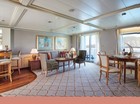
Available as a one-bedroom
configuration or as two-bedrooms
(as illustrated) by adjoining with
a Veranda Suite. ONE BEDROOM: 967–1,007 SQ. FT. / 90–94 M2 INCLUDING VERANDA (110–116 SQ. FT. / 10–11 M2);
TWO BEDROOM: 1,312–1,352 SQ. FT. / 122–126 M2
INCLUDING VERANDA (170–176 SQ. FT. / 16–17 M2)
• Large veranda with patio furniture and
floor-to-ceiling glass doors;
bedroom two has additional veranda
• Living room with sitting area; bedroom
two has additional sitting area
• Separate dining area and bar
• Twin beds or queen-sized bed;
bedroom two has additional twin
beds or queen-sized bed
• Marble bathroom with double
vanity, separate shower and full-sized
whirlpool bath, plus a powder room;
bedroom two has additional marble
bathroom with full-sized bath
• Walk-in wardrobe(s) with personal safe
• Vanity table(s) with hair dryer
• Writing desk(s)
• Flat-screen television(s) with
Interactive Media Library
• Bose® sound system with
bluetooth connectivity
• Illy® espresso machine
• Unlimited Premium Wifi
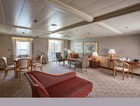
Available as a one-bedroom
configuration or as two-bedrooms
(as illustrated) by adjoining with a
Veranda Suite. ONE BEDROOM: 941–1,090 SQ. FT. / 87–101 M2
INCLUDING VERANDA (103–116 SQ. FT. / 10–11 M2);
TWO BEDROOM: 1,286-1,435 SQ. FT. / 119–133 M2
INCLUDING VERANDA (163–176 SQ. FT. / 16–17 M2)
Large veranda with patio furniture and
floor-to-ceiling glass doors;
bedroom two has additional veranda
• Living room with sitting area; bedroom
two has additional sitting area
• Separate dining area and bar
• Twin beds or queen-sized bed;
bedroom two has additional twin
beds or queen-sized bed
• Marble bathroom with double
vanity, separate shower and full-sized
whirlpool bath, plus a powder room;
bedroom two has additional marble
bathroom with full-sized bath
• Walk-in wardrobe(s) with personal safe
• Vanity table(s) with hair dryer
• Writing desk(s)
• Flat-screen television(s) with
Interactive Media Library
• Bose® sound system with
bluetooth connectivity
• Illy® espresso machine
• Unlimited Premium Wifi
Available as a one-bedroom
configuration or as two-bedrooms
(as illustrated) by adjoining with
a Vista Suite. ONE BEDROOM: 919 SQ. FT. / 85 M2
INCLUDING VERANDA (220 SQ. FT. / 20 M2);
TWO BEDROOM: 1,264 SQ. FT. / 117 M2
INCLUDING VERANDA (220 SQ. FT. / 20 M2) Large veranda with patio
furniture and floor-to-ceiling glass
doors; bedroom two has additional
large picture window
• Living room with sitting area; bedroom
two has additional sitting area
• Separate dining area and bar
• Twin beds or queen-sized bed;
bedroom two has additional twin
beds or queen-sized bed
• Marble bathroom with double
vanity, separate shower and full-sized
whirlpool bath, plus a powder room;
bedroom two has additional marble
bathroom with full-sized bath
• Walk-in wardrobe(s) with personal safe
• Vanity table(s) with hair dryer
• Writing desk(s)
• Flat-screen television(s) with
Interactive Media Library
• Bose® sound system with
bluetooth connectivity
• Illy® espresso machine
• Unlimited Premium Wifi
Inclusions
• Voyage on board in selected cabin category
• Butler service in every suite
• All meals on board*
• Beverages on board (Select wines, spirits and non-alcoholic beverages)
• Crew Gratuities (Excluding Spa & salon staff)
• Expedition excursions
• Lectures and entertainment on board
• Free wif-fi (Subject to coverage)
• Laundry service included for certain fare categories
• Self service laundry facilities available
• In country flights where required by the itinerary
*Some onboard restaurants incur an additional cost
• PRIVATE EXECUTIVE TRANSFERS
• ECONOMY CLASS FLIGHTS or Business Class upgrade at reduced rates
• AIRPORT TRANSFERS
Exclusions
• International flights unless otherwise stated
• Passport and visa costs if applicable
• Travel insurance
• Optional shore excursions
• Spa and Salon Treatments
• Complete valet services, including laundry, pressing and dry cleaning, are available at an additional charge
